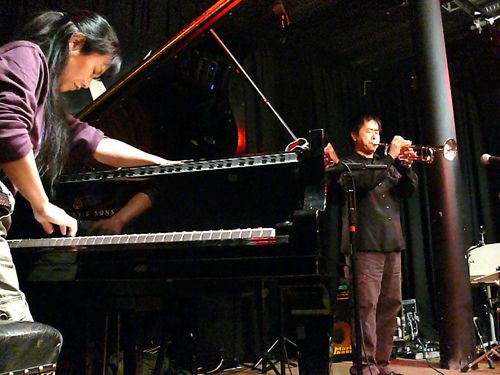By Andrew Hamlin
Northwest Asian Weekly

Satoko Fujii Orchestra
Make a joyful noise onto the tape. Failing that, make a noise, any noise, onto the tape. It doesn’t have to be music, it doesn’t have to be the dictionary definition of music, noise, or anything. Just leave an impression. That is the first rule of recording.
But Japanese pianist/composer Satoko Fujii, and her collaborators, will severely bend that rule, and several other rules, before they are done. They live on the frontiers of jazz and the frontiers of sound.
They like it there. You might say they’ve settled in.
 But Fujii has to test other extremes, too—to know them for extremes. “Ichigo Ichie,” credited to the “Satoko Fujii Orchestra Berlin,” begins in a fusillade of percussion, drum noise rolling over itself and rearing up again for another forward flip. The CD credits two drummers, Michael Griener and Peter Orins, and it’s easy to believe the two play at once. On repeated listenings however, we can get inside the sound (something not easily done with a wave) and learn the parts, repeating and non-repeating, somersaulting forward.
But Fujii has to test other extremes, too—to know them for extremes. “Ichigo Ichie,” credited to the “Satoko Fujii Orchestra Berlin,” begins in a fusillade of percussion, drum noise rolling over itself and rearing up again for another forward flip. The CD credits two drummers, Michael Griener and Peter Orins, and it’s easy to believe the two play at once. On repeated listenings however, we can get inside the sound (something not easily done with a wave) and learn the parts, repeating and non-repeating, somersaulting forward.
“Ichigo Ichie” consists of four variations on the title theme, but its expositions reach out to far corners. Natsuki Tamura, Fujii’s husband and frequent collaborator, was one of three trumpeters on the project.
He recalls, in his liner notes, that the most difficult part for the trumpet players was holding high notes for a long time. They did that until their embouchures practically gave out. Such practices can be dangerous. Louis Armstrong and other trumpets suffered split lips. But Fujii led and the others bravely followed.
“Yamiyo Ni Karasu,” credited to “Satoko Fujii Tobira,” combines Fujii, Tamura, bassist Todd Nicholson, and drummer Takashi Itani. Through seven selections, the solo sections stuck most with me. Nicholson, working his solo bass as even Itani dropped out, lonely in the wilderness of otherwise silence and stuck with the softest-sounding instrument of the four, but determined to manifest a structural logic and an emotional resonance, on his own. Itanti flicking a cymbal, playing along its edge for a long whine.
Nicholson again, bowing multiple notes simultaneous, as high up into a violin-like range as his big deep axe allows. Fujii lays out for long stretches, leading by silence.
 The “Uminari” CD comes from the “Kaze” band—Fujii of course, Tamura, Peter Orins from the Berlin album on drums, and a second trumpeter (not from the Berlin session), Christian Pruvost. The two trumpeters spend an enormous amount of time making sounds not normally issued from trumpets, or at least, not intentionally. Duck farts. Liquid swishes. Suggestions of unknown tongues muttered. Orins augments on diverse percussives, and Fujii sometimes plays the inside of her piano to a zither-like tone.
The “Uminari” CD comes from the “Kaze” band—Fujii of course, Tamura, Peter Orins from the Berlin album on drums, and a second trumpeter (not from the Berlin session), Christian Pruvost. The two trumpeters spend an enormous amount of time making sounds not normally issued from trumpets, or at least, not intentionally. Duck farts. Liquid swishes. Suggestions of unknown tongues muttered. Orins augments on diverse percussives, and Fujii sometimes plays the inside of her piano to a zither-like tone.
But the two brass players take the sound up and down and all around—and for several crucial minutes, they take it down to almost nothing at all. I strained to hear any action other than the overtones of my whirling fan against the August heat, traffic drone, sidewalk cursing, the odd thumpings (never any rhythm or schedule) of my downstairs neighbor. I caught the two trumpeters in my ear, but I caught everything else too.
And that may well be their point. After all, John Cage had a famous piece of four minutes and thirty-three seconds of its performers standing around doing nothing. And you’re supposed to hear how much noise “nothing” actually takes up. The quartet is so consumed with the outer edges, it’s easy to forget how they roll over to harmonies, choruses, verses, middle-eights—the stuff jazz is supposed to be made of. But they want to remember the expanded, maybe exploded, picture, of what’s possible. And they want you to see it (hear it) that way, too. (end)
Andrew Hamlin can be reached at info@nwasianweekly.com.



